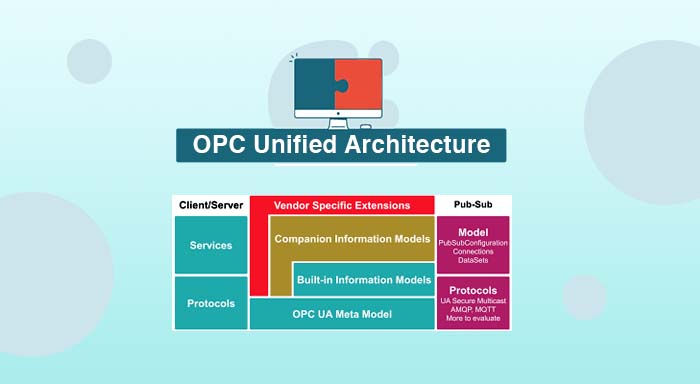Regarding industrial automation and communication, the OPC Unified Architecture (OPC UA) is a particular one. The evolution of the previously mentioned OPC Classic, OPC Unified Architecture (OPC UA) is special due to its platform independence and service-oriented architecture making it indispensable throughout multiple systems and devices in the industrial space. First published in 2008 by the OPC Foundation, OPC Unified Architecture (OPC UA) is an enhanced version of the original three specifications offering a more secure, upwardly scalable, and dependable communication mechanism.
What is OPC Unified Architecture (OPA UA)?
OPC Unified Architecture (OPC UA) is an open, platform-independent, service-oriented middleware that incorporates functionalities from the former OPC Classic specifications into an extensible framework. Herein lies an advantage in achieving a smooth transition to more secure and highly scalable solutions. OPC Unified Architecture (OPC UA) works in every industry in a broad modality irrespective of different systems and industries Apart from this, it uses transport protocols likes TCP, and HTTPS in the client-server model, or UDP, AMQP, and MQTT in the publisher-subscriber model.
Main Characteristics of OPC Unified Architecture (OPC UA)
Platform Independence:
Concerning the hardware environment, OPC Unified Architecture (OPC UA) can be used at different types of computers starting from traditional PCs and up to the cloud services, PLCs, and microcontrollers. It works well with Windows operating systems and the other versions like Mac OS X, Linux, and Android operating systems hence enhancing versatility.
Security:
Protections are also very important in OPC Unified Architecture (OPC UA) achieving encryption, authentication, and last, but not least; auditing to counter threats. For instance, it uses session encryption, message signing, as well as authentication through X509 certificates to safeguard the connection between clients and servers.
Comprehensive Information Modeling:
OPC Unified Architecture (OPC UA) translates data into valuable information by using an attribute-oriented, information-based modeling system. This approach enables the modeling of such compound multi-level hierarchies, which gives a procedure to industries on how they can reveal such data using OPC Unified Architecture (OPC UA).
Extensibility:
The OPC Unified Architecture (OPC UA) provides for layered architecture providing for the incorporation of new technologies and methodologies in the current applications. This makes it possible to fit in with the current products as well as the future products.
Functional Equivalence and More:
However, in comparison with OPC Classic, OPC Unified Architecture (OPC UA) extends the functional possibilities: Discovery services, hierarchical address spaces, Subscriptions for monitoring changes in data, Event notifications, and Methods for the execution of server-specific applications.
Some of the OPC Unified Architecture (OPC UA) Applications in Industrial Automation
OPC Unified Architecture (OPC UA) finds its applications in industrial automation, especially for enabling machine-to-machine and machine-to-enterprise communication. It is useful in harmonizing Field Devices, Control Systems, MESs & ERP that facilitate information exchange and command &/or control of processes. This capability makes OPC Unified Architecture (OPC UA) an essential enabler of smart manufacturing processes and Industry 4. Facilitating 0 initiatives for which data sharing and exchange are a necessity coupled with the interconnectivity that is obligatory.
OPC Unified Architecture (OPC UA) and Industry 4. 0
It could be due to the emergence of the fourth industrial revolution also known as Industry 4. 0, and especially due to the emergence of the Industrial Internet of Things (IoT) that requires more secure and standardized exchange of data between devices through IoT communication protocols. Integration of OPC Unified Architecture (OPC UA) assists in fulfilling these requirements in this regard by enabling devices to self-start communications to increase effectiveness and performance in most industries.
OPC Unified Architecture (OPC UA)'s Future vv
Cloud Integration and Relay:
OPC Unified Architecture (OPC UA) keeps on developing and in this release, the emphasis is made on improving the cloud support. The future features include the ability to relay through the cloud for better connection and metadata support for services as Azure, AWS, and Google Cloud.
Deterministic Communication:
As network concepts like 5G, Wi-Fi 6/7 are the prevailing demands in the world, OPC Unified Architecture (OPC UA) is expected to improve determinable communication—the must-have in real-time data management for industries.
Conclusion
OPC Unified Architecture (OPC UA) stands as a cornerstone in the realm of industrial communication, offering secure, adaptable, and scalable solutions to meet the current and future demands of the automation industry. Whether you are working in manufacturing, logistics, or any sector relying on automation, understanding OPC Unified Architecture (OPC UA) can provide significant insights into optimizing and securing your operations.
OPC Unified Architecture (OPC UA) - Frequently Asked Questions
1. What is the purpose of OPC Unified Architecture (OPC UA)?
OPC Unified Architecture (OPC UA) is the means of communication for Large Scale Industrial Automation systems to share data. It also ensures highly dependable messaging for the assessment and command of manufacturing procedures.
2. How does OPC Unified Architecture (OPC UA) bring security improvement?
Security also rises through session encryption, message signing, and authentication on OPC Unified Architecture (OPC UA). It adopts secure communication protocols and certificates to guarantee that the communication and data transfer are made without compromising on security.
3. Does OPC Unified Architecture (OPC UA) work with different operating systems?
Yes, OPC Unified Architecture (OPC UA) is designed to operate across different platforms, whether it is Windows, Linux OS, or macOS making it conversant with cross-platform industrial applications.
4. How does OPC Unified Architecture (OPC UA) support Industry 4.0?
OPC Unified Architecture (OPC UA) supports Industry 4.0 by providing a standardized communication protocol that allows devices to communicate seamlessly. It enables the integration of industrial processes with enterprise-level applications, facilitating smart manufacturing and IoT applications.
5. What are the future trends for OPC Unified Architecture (OPC UA)?
The future of OPC Unified Architecture (OPC UA) includes enhanced cloud integration, deterministic communication capabilities, and additional protocol mappings to support evolving industrial needs with technologies like 5G and Wi-Fi 6/7.
Related Posts
What Is ZigBee? | A Comprehensive Guide
Bluetooth Low Energy | Powering the IoT Revolution
Understanding Z-Wave Technology | The Future of Smart Homes
LoRaWAN Simplified | Work, Components, Applications And Advantages
Narrowband IoT (NB-IoT) is Transforming Industries From Smart Cities to Agriculture



